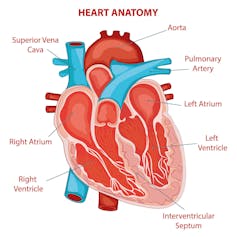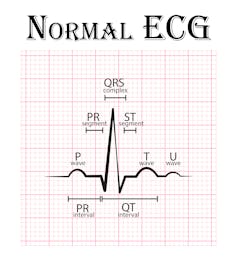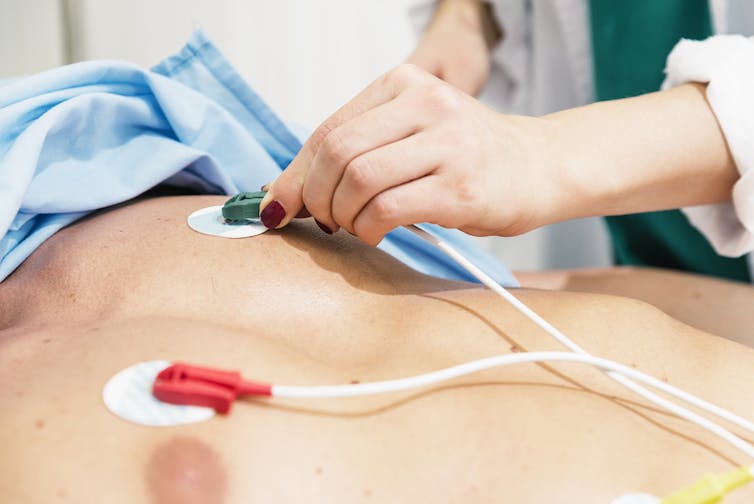Your Apple Watch can now record your ECG – but what does that mean and can you trust it?
- Written by Shane Nanayakkara, Cardiologist, Baker Heart and Diabetes Institute
Apple’s new, fourth-generation watch has an electrical heart rate sensor. This can record your electrocardiogram or ECG, which Apple says:
… can classify if the heart is beating in a normal pattern or whether there are signs of atrial fibrillation (AFib), a heart condition that could lead to major health complications.
So, what actually is an ECG and can you really rely on a watch to read it?
How does the heart beat?
As a quick summary, your heart is divided into four chambers. The two top chambers (called atria) receive blood and push it towards the two bottom chambers (ventricles), which pump blood out to the body (left side) and the lungs (right side).
At the top of the right atrium is a little collection of cells called the sinoatrial node, or SA node. These generate an electrical signal which travels toward the middle of the heart (atrioventricular node). Finally, this electrical impulse spreads into the ventricles, which makes them squeeze blood for what we feel as a heartbeat or pulse. A normal heart rate can vary significantly between different people.
Read more: What should my heart rate be and what affects it?
So, these small electrical currents help co-ordinate each beat. In the early 1900s, Willem Einthoven developed a machine to be able to record these signals (for which he was awarded the Nobel Prize) – a device that developed into the modern-day ECG machine.
 Your heart is made up of four chambers.
from shutterstock.com
Your heart is made up of four chambers.
from shutterstock.com
An ECG involves having small stickers applied to your chest, shoulders and ankles, which can then read the electricity coming from your heart. You don’t feel anything when it is taken and it takes only a few seconds to make a recording. It can be done at your local GP clinic or in hospital.
How does an ECG work?
With every beat, there is a characteristic appearance of each signal on the ECG, with separate “waves” that correspond to electrical activity from different parts of the heart.
The P wave (before the spike) represents the atria squeezing blood down towards the ventricles. The QRS looks like a spike and represents the two ventricles squeezing blood to the body and lungs. And the T wave at the end reflects the recovery of the ventricles as they relax to receive blood again.
 Each beat is represented by a separate wave or spike on the ECG.
from shutterstock.com
Each beat is represented by a separate wave or spike on the ECG.
from shutterstock.com
By analysing various segments, the person reading the ECG can understand about problems, signalled by an abnormal-looking ECG, in the heart. The ECG can usually detect severe or urgent heart attacks, which cause elevation of the segment between the QRS and T waves. Smaller heart attacks sometime show signs, but not always.
The ECG is good for detecting arrhythmias, which are abnormal rhythms. The most common arrhythmia is atrial fibrillation (AF) – this is where the top chambers (the atria) don’t squeeze properly. As a result blood can stagnate and form a clot, which can then go to the brain and cause a stroke.
You can see atrial fibrillation on an ECG when no P wave is visible. Instead there are often small irregular blips indicating that the atrium is beating in a weak and disorganised way. An ECG can also pick up other arrhythmias, though it is most useful if the person is in the abnormal rhythm at the time the ECG is done.
The ECG can also pick up abnormal heart structures. Sometimes it can show signs of the heart being weak (heart failure) or if the muscle is unusually thick, such as when people have high blood pressure for a long time.
So, can the Apple Watch actually read your heart?
The ECG at your local doctor is called a 12-lead ECG. Only ten leads are physically attached to you, but the machine derives 12 based on the direction of electrical flow. Each of these leads provide a different view of the heart.
Imagine you are peering into a room through several windows. Each window would give you a different perspective, and putting these together can give you an overall impression of the room.
Wearable ECGs, like that with the Apple Watch, can pick up only one lead (for your further reading, it’s lead I). This can tell if your heart is irregular and sometimes if there is no P wave (so it could potentially detect atrial fibrillation).
 An ECG involves several stickers placed on your chest.
from shutterstock.com
An ECG involves several stickers placed on your chest.
from shutterstock.com
A key advantage of having the Apple Watch is the ability to take a 30-second ECG (this requires you to put your right hand on the watch to form a circuit so the electrical signals can be read from both arms through your heart) at the time you feel symptoms. It can understand the context as well (for example, your activity level at the time).
There are drawbacks, though. The watch can only give a single-window view of what’s happening in the heart, and won’t be able to detect heart attacks or abnormal heart structure accurately. Wearable devices are also more prone to interference with the signal as they rely on just one lead, whereas a 12-lead ECG remains the gold standard.
Read more: New Apple Watch adds heart tracking: here's why we should welcome ECG for everyone
And, of course, the actual ECG must be read by a professional. Apple gives you the option to download your reading as a PDF.
Ultimately, if you have concerns about your heart, an ECG is a simple, non-invasive, cheap test, which your local doctor can interpret. It should always be accompanied by a detailed history of your symptoms and a physical examination.
Authors: Shane Nanayakkara, Cardiologist, Baker Heart and Diabetes Institute



















